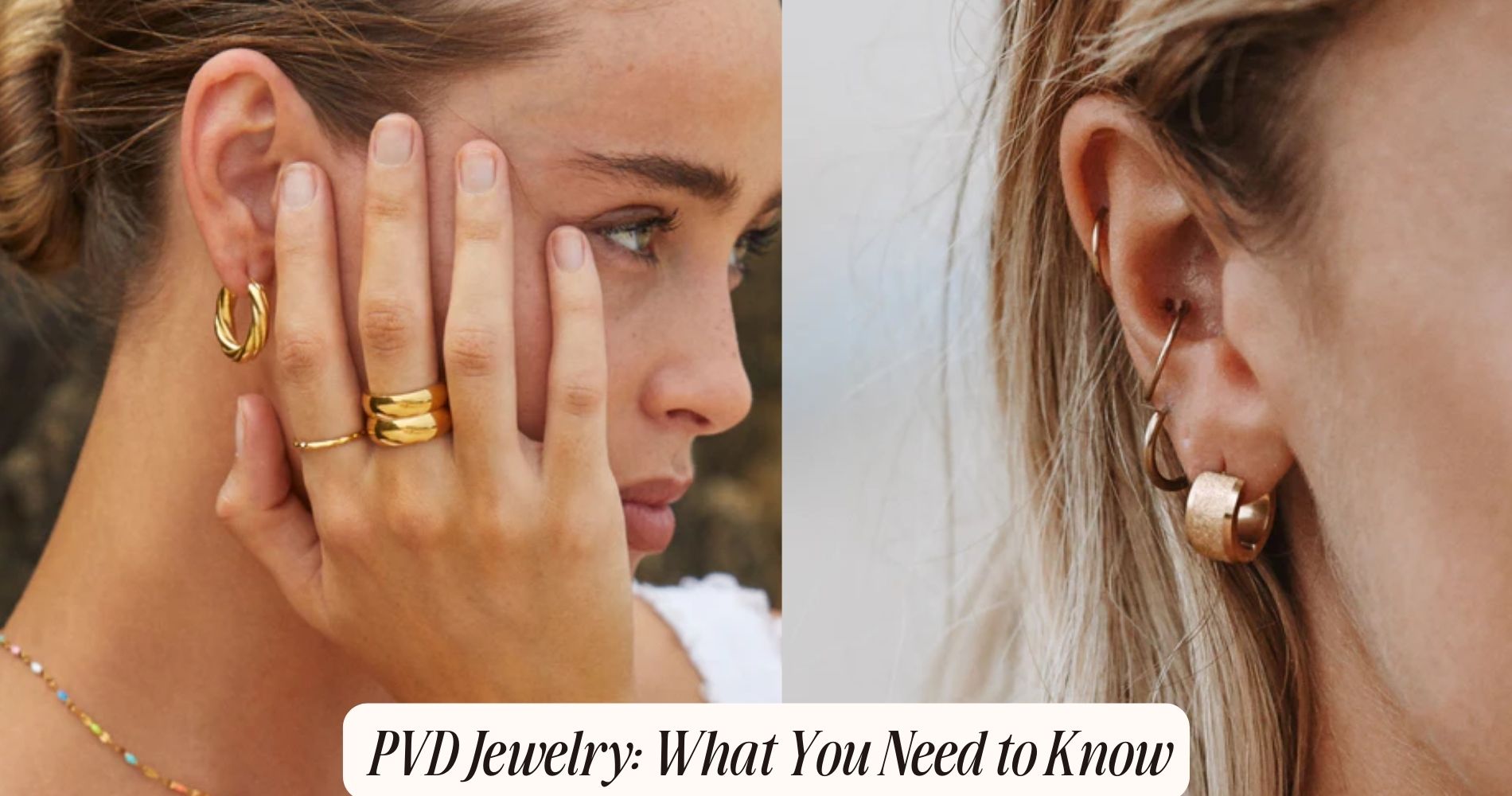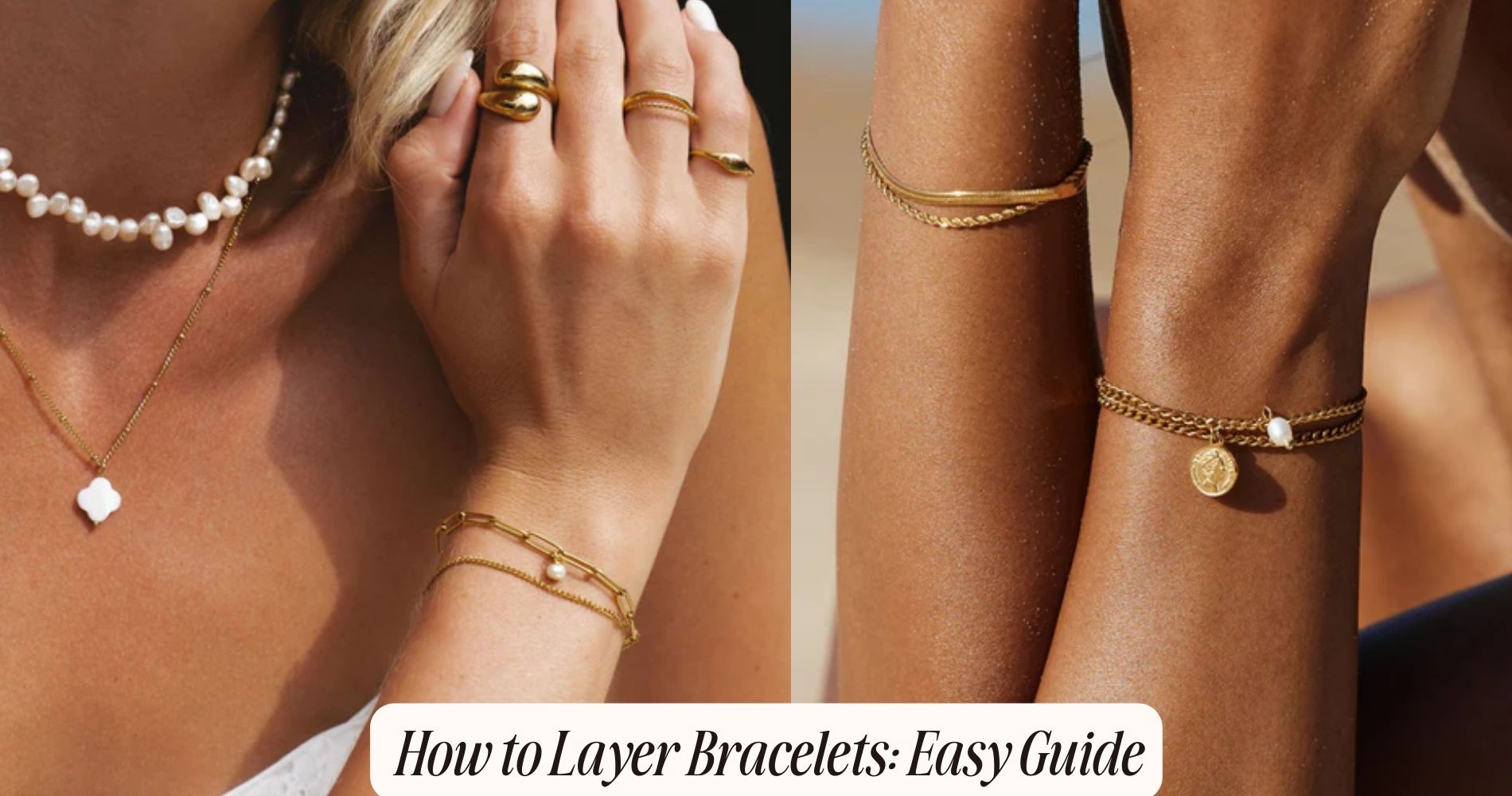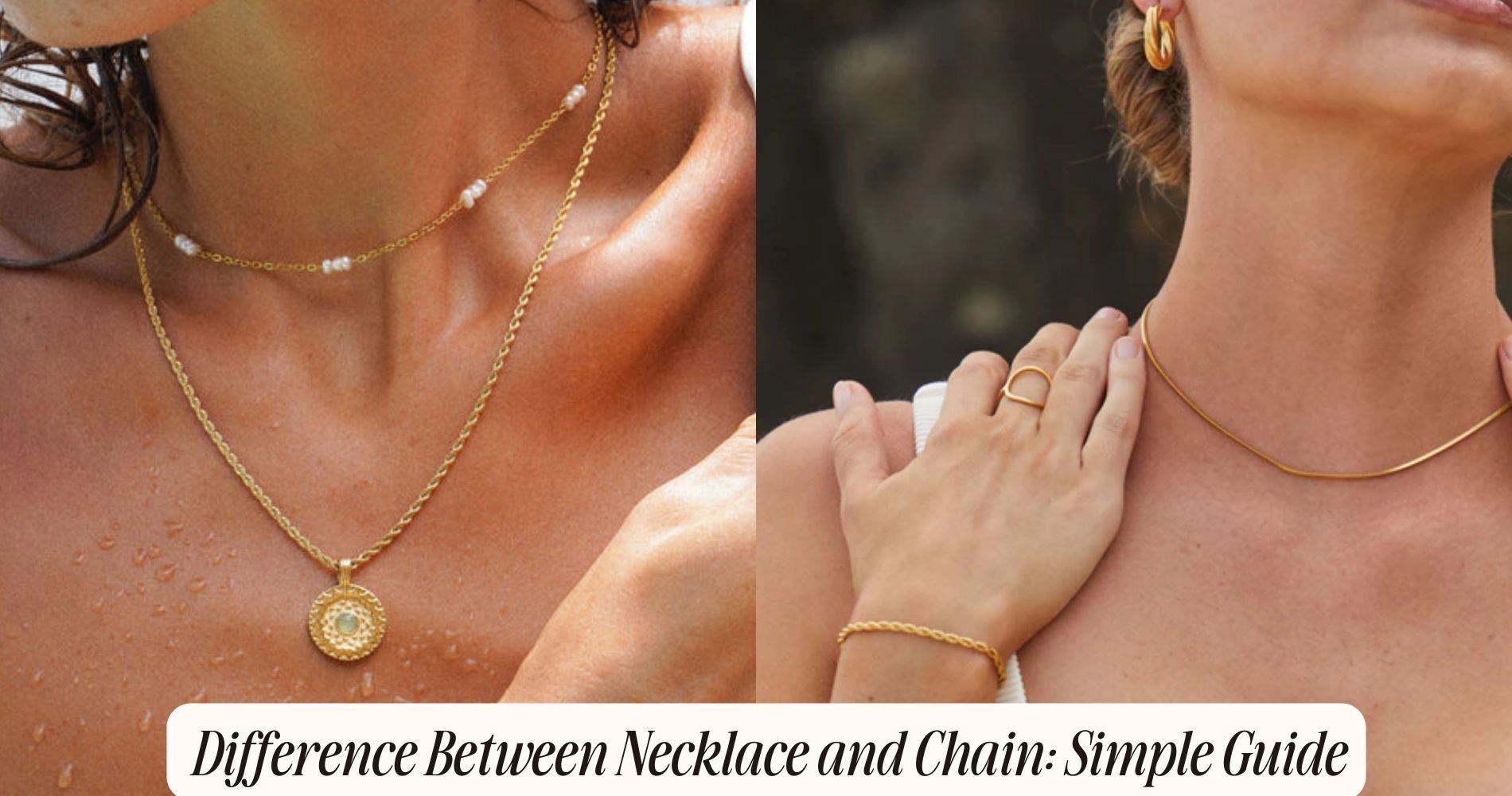
PVD Jewelry: What You Need to Know
PVD jewelry uses a high-tech vacuum deposition process, vaporizing solid material to coat pieces with ultra-thin, durable layers. You'll find PVD coatings in hues like gold, rose gold, and black, providing hard, scratch-resistant finishes that repel corrosion and tarnish. Commonly applied materials include titanium nitride and zirconium nitride. This method outperforms electroplating in durability and environmental impact, though it comes with higher initial costs. To care for your PVD jewelry, clean with a soft microfiber cloth and store in dry, shaded areas. Interested in how PVD elevates your jewelry's longevity and aesthetic appeal? Explore our Hypoallergenic Jewelry collection, featuring durable and skin-friendly options.
What Is Pvd?
PVD, or Physical Vapor Deposition, is a cutting-edge coating process that involves the vaporization of solid material in a high vacuum environment to form a thin, solid layer on the surface of jewelry pieces. The history origins of PVD can be traced back to the 19th century, but it wasn't until the mid-20th century that advances in vacuum technology made it viable for industrial applications.
Initially used in aerospace and microelectronics, PVD's application industries have since expanded to include jewelry, offering unparalleled durability and aesthetic appeal.
In the jewelry industry, PVD coating has revolutionized how manufacturers approach surface finishing. Unlike traditional methods, PVD provides a finish that isn't only visually stunning but also highly resistant to wear, corrosion, and tarnishing. This makes it particularly valuable for pieces that undergo frequent handling and exposure to the elements.
You'll find PVD coatings in a variety of hues, from classic gold and silver to more exotic shades like rose gold and black, achieved through different metal combinations and gases during the process.
How PVD Coating Works
PVD coating involves a vacuum deposition process where material is vaporized and then condensed onto the jewelry surface.
It's important to take into account material compatibility, as certain substrates bond better with the coating, enhancing adhesion.
This process greatly enhances the durability and longevity of the jewelry, making it resistant to wear, corrosion, and tarnishing.
PVD Coating Process
The PVD coating process entails the deposition of thin film layers onto jewelry substrates through a vacuum environment, utilizing techniques such as sputtering or evaporation to achieve enhanced durability and aesthetic appeal.
You start by placing the jewelry inside a vacuum chamber, which guarantees the absence of contaminants that could interfere with coating adhesion. The target material, often a metal like titanium or chromium, is then bombarded with high-energy particles.
In the sputtering technique, ions from a plasma are accelerated towards the target material, causing atoms to eject and deposit onto the jewelry substrate. Alternatively, evaporation involves heating the target material until it vaporizes, allowing the vapor to condense onto the jewelry surfaces. Both methods create a thin, uniform layer that can be precisely controlled for thickness and composition.
Throughout this process, maintaining a consistent vacuum environment is essential. It ensures that the deposition occurs uniformly, enhancing the final product's resistance to wear and corrosion. The choice of target material and process parameters, such as deposition rate and substrate temperature, plays an important role in achieving the desired coating properties.
Material Compatibility
To guarantee excellent adhesion and longevity, it's important to understand how different substrate materials interact with PVD coatings. Metal suitability is vital when selecting a substrate for PVD-coated jewelry. Stainless steel, titanium, and cobalt-chrome alloys are commonly used due to their excellent compatibility. These metals provide a stable base that enhances the adhesion of the PVD layer, resulting in a more durable finish.
Surface preparation is equally important in the PVD process. Before applying the coating, the substrate must be meticulously cleaned and polished. Any contaminants, such as oils or residues, can greatly impact the adhesion quality. Techniques like ultrasonic cleaning, followed by a vacuum drying process, are often employed to ensure an immaculate surface. Additionally, some substrates may require a pre-coating treatment to enhance the bonding strength between the metal and the PVD layer.
Understanding these nuances ensures that the PVD coating adheres uniformly and effectively. By selecting suitable metals and ensuring thorough surface preparation, you can achieve a high-quality finish that not only looks stunning but also withstands the rigors of daily wear.
This meticulous approach guarantees that your PVD-coated jewelry will maintain its luster and integrity over time.
Durability and Longevity
Understanding the durability and longevity of PVD coatings involves delving into the intricate processes that create a robust, wear-resistant finish. Physical Vapor Deposition (PVD) is a high-tech vacuum coating method where material is vaporized and then condensed onto the jewelry surface. This results in an ultra-thin, yet extremely hard layer that greatly enhances scratch resistance.
You'll appreciate the minimal maintenance required for PVD-coated jewelry. The process not only guarantees a brilliant, long-lasting finish but also creates a barrier that repels corrosion and tarnishing. This means your jewelry retains its luster and looks new with little effort on your part.
In the industry, PVD coatings are prized for their exceptional hardness, often exceeding that of traditional plating methods. The molecular bonding during the deposition process ensures the coating is tightly adhered to the jewelry, making it less prone to chipping or peeling. This durability means your PVD-coated pieces can withstand daily wear and tear, from casual use to more demanding environments.
Benefits of PVD Jewelry
When you choose PVD jewelry, you're opting for an advanced coating technology that greatly enhances durability and longevity compared to traditional plating methods.
Its hypoallergenic properties make it ideal for sensitive skin, reducing the risk of irritation.
Additionally, PVD allows for a wide range of color options, ensuring you can find the perfect hue to match your aesthetic preferences.
Durability and Longevity
PVD jewelry stands out for its exceptional durability and longevity, thanks to the advanced physical vapor deposition process that creates a tough, wear-resistant coating. The PVD process involves vaporizing a metal and bonding it to the surface of the jewelry at the molecular level. This results in a coating that offers superior scratch resistance, protecting your jewelry from everyday wear and tear. You'll find that PVD-coated pieces maintain their pristine appearance much longer than those with traditional coatings.
In addition to scratch resistance, PVD jewelry boasts excellent corrosion resistance. This means your jewelry is less likely to tarnish or degrade when exposed to elements like moisture, sweat, and various chemicals. Unlike traditional plating methods, which can wear off over time, PVD coatings are known for their robustness and adherence to the base material.
You'll notice that PVD jewelry retains its color and finish for years, making it a wise investment. Whether you're wearing it daily or for special occasions, PVD jewelry offers long-lasting durability without compromising on style or quality.
Hypoallergenic Properties
Thanks to its hypoallergenic properties, PVD jewelry is an excellent choice for individuals with sensitive skin or metal allergies. The PVD (Physical Vapor Deposition) process creates a coating that's not only durable but also greatly reduces the risk of skin reactions. By utilizing advanced vacuum deposition techniques, PVD applies a thin, but highly resilient layer of material that offers substantial allergen resistance.
You won't have to worry about common irritants like nickel, which is a frequent culprit in allergic reactions. PVD coatings are typically applied to metals such as stainless steel or titanium, both known for their hypoallergenic attributes. The result is a jewelry piece that maintains its aesthetic appeal while offering superior resistance to allergens.
In the jewelry industry, PVD's hypoallergenic properties are increasingly recognized as a critical benefit. This makes it an ideal option for everyday wear, even for those with the most sensitive skin. Additionally, the process ensures that the surface of the jewelry remains smooth and non-reactive, providing an extra layer of protection against skin irritations.
Color Variety Options
Ever wondered how jewelry can achieve such a vast array of colors while maintaining durability and brilliance? The answer lies in Physical Vapor Deposition (PVD) technology. With PVD, metals are vaporized in a high-tech vacuum chamber and then condensed onto the jewelry surface, creating a thin yet resilient coating. This process allows for unique shades that aren't possible with traditional plating methods.
PVD jewelry offers an impressive spectrum of colors, from classic gold and silver to modern hues like rose gold, gunmetal, and even vibrant blues and purples. These unique shades are achieved through precise control over the metal vapors and reactive gases used during the deposition process. This level of customization is perfect for staying ahead of fashion trends.
Moreover, PVD coatings are known for their exceptional hardness and wear resistance, ensuring that your jewelry retains its vibrant color for longer periods. Unlike traditional plating, PVD doesn't chip or tarnish easily, making it an ideal choice for daily wear.
Types of PVD Coatings
Among the various types of PVD coatings, titanium nitride (TiN), zirconium nitride (ZrN), and chromium nitride (CrN) stand out for their superior hardness, corrosion resistance, and aesthetic appeal in jewelry applications.
When you're dealing with PVD processes, these coatings are applied in a vacuum chamber using advanced deposition techniques such as cathodic arc deposition or magnetron sputtering. These methods guarantee that the coating adheres uniformly, providing a durable finish.
Titanium nitride (TiN) is renowned for its golden hue and exceptional hardness, making it perfect for high-wear jewelry pieces. Zirconium nitride (ZrN) offers a lustrous, yellow-gold finish that rivals traditional gold plating but with enhanced durability. If you're looking for a more subdued yet equally resilient option, chromium nitride (CrN) provides a sleek, silver-gray appearance and excellent wear resistance.
These coatings not only enhance the visual appeal of jewelry but also significantly prolong its lifespan. By choosing the right PVD coating, you guarantee that your jewelry remains scratch-resistant and maintains its luster over time. Understanding the attributes of each type helps you make informed decisions tailored to your specific needs.
Comparing PVD and Other Methods
When comparing PVD (Physical Vapor Deposition) to other surface treatment methods like electroplating and anodizing, it's crucial to take into account factors such as durability, environmental impact, and application versatility. PVD coatings excel in durability, offering superior wear resistance and hardness compared to electroplating, which is prone to chipping and peeling over time. Anodizing, while providing good corrosion resistance, doesn't match the hardness levels achieved by PVD.
From an environmental impact perspective, PVD is a more eco-friendly option. The process doesn't involve hazardous chemicals or produce toxic waste, unlike electroplating, which uses cyanide and other harmful substances. Anodizing, though less harmful than electroplating, still generates waste that requires careful disposal.
In terms of cost comparison, initial setup for PVD can be higher due to the advanced technology required. However, the long-term benefits, such as reduced need for re-coating and lower maintenance costs, often outweigh the initial investment. Electroplating might seem cheaper upfront but incurs higher costs over time due to frequent reapplications. Anodizing falls somewhere in between, being moderately priced but less durable than PVD.
Care Tips for PVD Jewelry
Proper care for PVD jewelry guarantees its longevity and maintains its pristine appearance, making it vital to adhere to specific maintenance guidelines. When it comes to cleaning methods, avoid abrasive materials and harsh chemicals. Instead, use a soft microfiber cloth and mild soapy water to gently clean the surface. Never submerge your PVD jewelry in cleaning solutions containing ammonia or bleach, as these can damage the coating.
For deeper cleaning, use an ultrasonic jewelry cleaner with caution. While these devices are generally safe, make sure the cleaning solution is non-abrasive and specifically designed for delicate jewelry. Additionally, avoid using high temperatures or prolonged exposure to ultrasonic waves, as they can weaken the PVD layer over time.
Storage solutions are equally important in preserving your PVD jewelry. Store each piece separately in a soft pouch or a lined jewelry box to prevent scratches and friction. Avoid placing PVD jewelry in direct sunlight or in humid environments, as prolonged exposure can degrade the finish. Consider using silica gel packets to reduce moisture levels in storage areas.
Popular PVD Jewelry Pieces
Now that you know how to care for your pieces, let's explore some of the most popular PVD jewelry items that are making waves in the industry. One standout is the PVD-coated stainless steel watch. These trendy designs offer an unmatched combination of durability and aesthetic appeal, making them a favorite among fashion-forward individuals. The PVD process enhances scratch resistance and provides a sleek, modern finish that stands the test of time.
Another must-have is PVD-treated earrings. These pieces often feature intricate patterns and bold colors, made possible by the precision of the PVD process. They're perfect statement pieces that can elevate any outfit, from casual wear to formal attire.
Chains and bracelets also benefit from PVD technology. Whether you prefer minimalistic styles or chunky, eye-catching links, PVD coatings maintain your jewelry's luster and vibrancy. This makes them ideal for everyday wear, resisting tarnish and discoloration.
Choosing Quality PVD Jewelry
Selecting quality PVD jewelry requires a discerning eye for craftsmanship, material integrity, and the effectiveness of the PVD coating process. Start by examining the base material of the jewelry; high-quality pieces often use stainless steel, titanium, or tungsten, which offer durability and resistance to corrosion. The precision and uniformity of the PVD (Physical Vapor Deposition) coating are important indicators of quality. Look for a smooth, even finish without any discoloration or patchiness.
Brand reputation is another significant factor. Established brands often invest in superior PVD technology and rigorous quality control measures. Research the manufacturer's history and their commitment to innovation and excellence in jewelry production. Customer reviews can provide invaluable insights into the real-world performance of the jewelry. Look for feedback on the longevity of the PVD coating and overall satisfaction with the piece.
Don't overlook the craftsmanship. Inspect the details such as clasps, links, and settings. Quality craftsmanship ensures that the PVD coating adheres properly and remains intact over time.
Frequently Asked Questions
How Long Does PVD Jewelry Typically Last?
PVD jewelry typically lasts several years, depending on durability factors like wear frequency and exposure to elements. Maintenance tips include regular cleaning and avoiding harsh chemicals to prolong its lifespan. Proper care guarantees maximum durability.
Is PVD Jewelry Safe for People With Metal Allergies?
Yes, PVD jewelry's typically hypoallergenic materials make it safer for people with metal allergies. However, you should still conduct allergy testing, as sensitivities vary. Industry insights suggest consulting professionals for personalized advice on hypoallergenic alternatives.
Can PVD Jewelry Be Resized or Repaired?
Resizing PVD jewelry presents challenges due to the coating's durability. Specialized repair techniques are essential to avoid damaging the PVD layer. Consult a professional jeweler experienced in handling PVD coatings for best results.
Does PVD Coating Change the Weight of the Jewelry?
The coating composition of PVD doesn't notably change the weight of the jewelry. PVD layers are extremely thin, resulting in a minimal weight impact, ensuring your jewelry maintains its original feel while gaining enhanced durability and aesthetics.
Are There Any Environmental Concerns With PVD Coating?
Yes, there are environmental concerns with PVD coating. The process involves significant resource consumption and can generate chemical waste. However, compared to traditional methods, PVD is generally more eco-friendly due to its reduced hazardous waste production.
Conclusion
To sum up, comprehending PVD jewelry provides you with the knowledge to make informed choices. You've learned about the PVD process, its benefits, and the different types of coatings available.
Compared to traditional methods, PVD offers superior durability and aesthetics. To guarantee longevity, follow specific care tips and select high-quality pieces.
Embrace PVD jewelry for its cutting-edge technology and enduring elegance, and you'll enjoy pieces that stand the test of time.

























Leave a comment
This site is protected by hCaptcha and the hCaptcha Privacy Policy and Terms of Service apply.